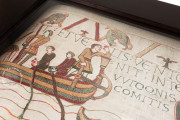The Bayeux Tapestry, also known as Tapisserie de Bayeux, is a beautiful example of skillfully embroidered cloth preserved in the town of Bayeux, Normandy, France. The tapestry, named after the French town, was probably produced in England, and unfortunately, the exact date remains unclear.
Woven Example of Romanesque Art
Technically speaking, the definition of tapestry refers to a cloth into which the design is woven, however, this is not the case with the Bayeux Tapestry, which should rather be referred to as embroidery.
As it depicts the events leading up to the battle of Hastings and the Norman conquest of England on behalf of William, Duke of Normandy, its creation’s terminus post quem should be the 1060s. The cloth, with its 70 meters in length and 50 cm in height, represents a supreme example of Norman Romanesque art.
Tapisserie de Bayeux: The Battle of Hastings and the Conquest of England
The tapestry tells the events that took place between 1064-1066, ending with the battle of Hastings. The two main protagonists are Harold Godwinson, King of England, and William, Duke of Normandy, also known as William the Conqueror.
King Harold, the last Anglo-Saxon king of England, was killed in the battle of Hastings on 14th October 1066. The English defeat ultimately endorsed the making of a new foreigner ruler, King William of Normandy, the first Norman King of England.
The Mystery of the Commissioner
The earliest written reference to the tapestry is a 1476 inventory of Bayeux Cathedral, at least four centuries after its production. The identity of the commissioner has been subject to a lot of speculation and scholars have come to agree on the figure of Bishop Odo, William’s half brother, although according to a French legend the tapestry was commissioned by Queen Matilda, William’s wife.
A View of the Past
The tapestry was probably commissioned by the Normans rather than the English, as it mainly depicts a Norman point of view. Although historical accuracy may have been distorted at times, in general, this piece of art provides a view of the life people lived at that time, with their every-day tools, weapons, apparel, and other objects.
We have 1 facsimile edition of the manuscript "Bayeux Tapestry": The Bayeux Tapestry facsimile edition, published by The Folio Society, 2016
Request Info / Price


















